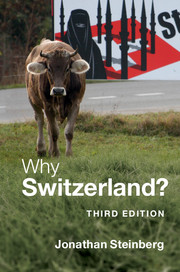8 - Switzerland and the European Union
Published online by Cambridge University Press: 05 November 2015
Summary
Twenty years ago when I finished the second edition of this book, Switzerland had not yet begun the process of negotiation with the European Union The bilateral treaties of 1999 and 2004 allowed Switzerland to participate in the internal market of the EU without actually becoming a member. I expected some solution like that as did the people I then interviewed. Nobody in the 1990s could remotely have imagined that by 2014 the European Union and Switzerland would be going through crises at the same time. To some extent, but not completely, the Swiss rejection of unlimited immigration in February 2014 and the critical situation of the European Union emerge from similar discontents: many Europeans distrust a remote, incomprehensible bureaucracy in Brussels and fear the way the foreigners have arrived in their communities.
The Swiss crisis involves other elements than its relationship to Europe: the blows to its prestigious financial institutions, the surrender of its bank secrecy law of 1934 and the mounting distrust between much of the population and its elites. In a deeper sense, both the EU and the Swiss Confederation have been hit hard by the spread of globalisation, the financial crisis of 2008 and its aftermath, the crumbling of the European financial institutions, the spectacular growth of the new plutocracy and the erosion of the powers of the nation-state. Now books have begun to appear on the way globalisation has become uncontrollable, and they are right; it has.
Switzerland and the European Union offer different models of federal states and the Swiss success in integrating Protestants and Catholics, three major languages, urban and rural communities and large and very small political identities has intriguing similarities to the European Union composed of states as large as the German Federal Republic and as small as Malta. Both the European Union and Switzerland have exceptionally complicated political systems, but the Swiss version has survived in its present form since 1848 and has been a great success, while the European Union in its various stages of evolution from the Benelux agreement signed in 1944 to the present has not found a final resolution of its problems of government after seventy years. The attraction of the Swiss model has led many observers to argue that EU reform ought to start with a new constitutional arrangement which would adopt Swiss solutions or at least consider the reasons for the Swiss success.
- Type
- Chapter
- Information
- Why Switzerland? , pp. 282 - 306Publisher: Cambridge University PressPrint publication year: 2015



